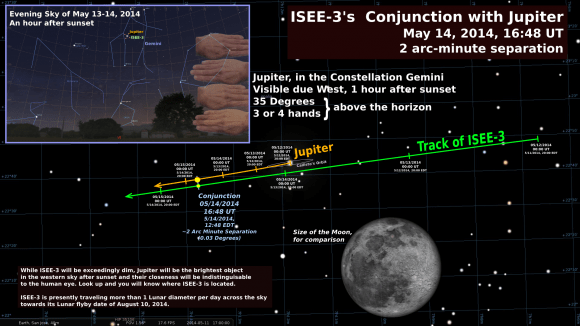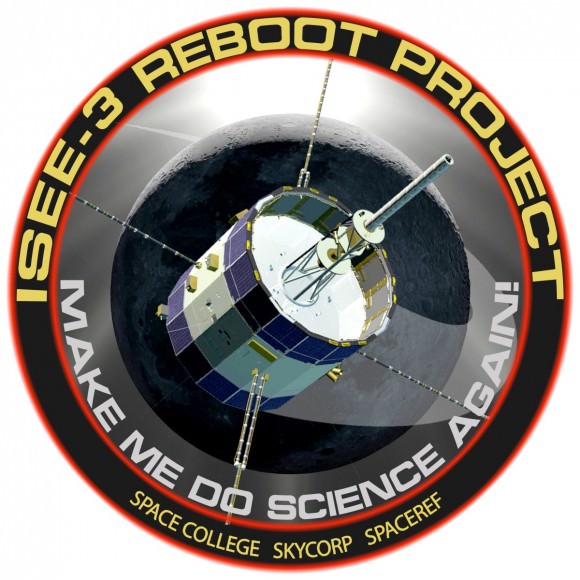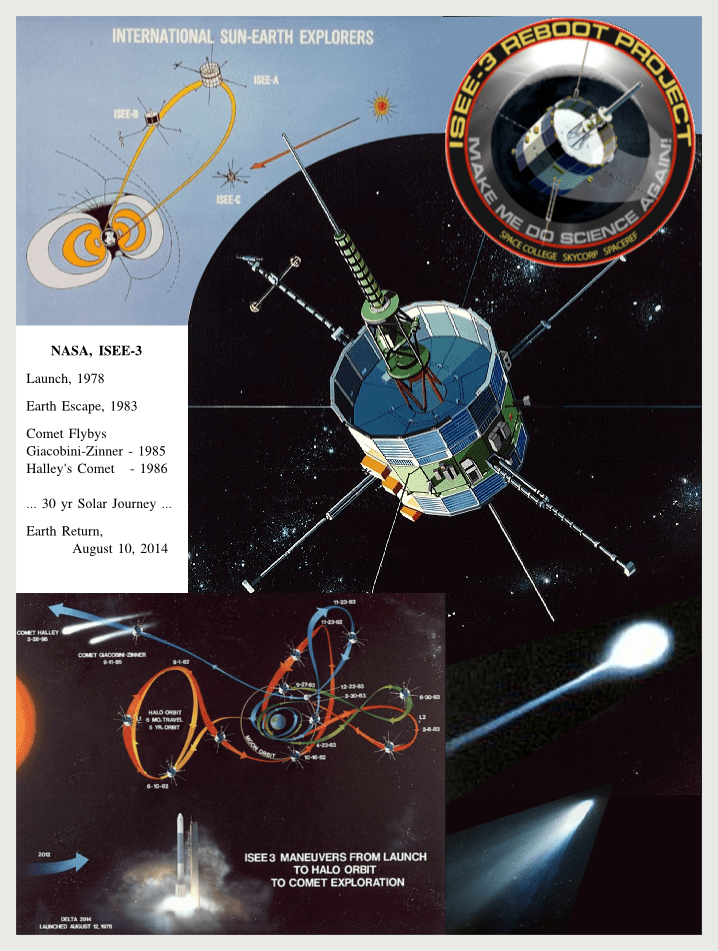Editor’s note: This guest post was written by Tim Reyes, a former NASA software engineer and analyst who has supported development of orbital and lander missions to the planet Mars since 1992.
The International Sun-Earth Explorer spacecraft (ISEE-3) is phoning home and will be returning whether we are ready or not. Launched in 1978 to study Earth’s magnetosphere, the spacecraft was later repurposed to study two comets. Now, on its final leg of a 30-plus year journey to return to Earth, there’s a crowdfunding effort called ISEE-3 Reboot aimed at reactivating the hibernating spacecraft since NASA is not offering any funding to do so.
Interestingly, on May 14th, the spacecraft will be in conjunction with the planet Jupiter, passing only 2 arc minutes from the giant gas planet. While the spacecraft is not visible to the human eye or optical telescopes, Jupiter on the 14th marks the spot where ISEE-3 resides in our night sky.

Here’s a bit of history on the program and this spacecraft in particular: The International Sun-Earth Explorers 1, 2 and 3 were the vanguard of what became an ongoing NASA program to monitor and understand the Sun-Earth relationship. ISEE-3 was part of a 3 spacecraft international effort to study the interaction of the Solar Wind with the Earth’s magnetosphere.
In 1982, NASA engineers at Goddard Space Flight Center, led by Robert Farquhar devised an unprecedented sequence of propulsion maneuvers including Earth and Moon gravitational assists to send the spacecraft ISEE-3 out of the Earth-Moon system. It was rechristened as the International Cometary Explorer (ICE) to rendezvous with two comets – Giacobini-Zinner in 1985 and Comet Halley in 1986.
The trajectory given ISEE-3 to escape the Earth-Moon system and flyby comets included returning to Earth on August 10, 2014. Final tweaks to the trajectory were completed in 1987 to assure a flyby of the Moon which Farquhar knew could be used to return ISEE-3 to an Earth orbit.

Enter the 21st Century, 30 years later and documents and magnetic tapes have predictably disappeared. The software and hardware to program, command and transmit to ISEE-3 are long gone. An independent team of engineers, led by Dennis Wingo and Keith Cowing (the same leaders of the Lunar Orbiter Image Recovery Project (LOIRP) — recovering old imagery on magnetic tape reels from the first lunar orbiter missions), operating outside the ranks and hallways of NASA are now racing against the clock to accomplish a landmark achievement: to turn on, command and maneuver a NASA spacecraft long ago abandoned, its primary missions completed in the 1980s. There are no funds, no remaining hardware or mission software to execute but this is the 21st century.
As of this writing there are five days left to contribute to this project, which is at 92% of its goal.
“ISEE-3 Reboot” team leader Dennis Wingo, says that if the efforts to contact the spacecraft are successful, plans are to return the spacecraft to the Sun-Earth L1 Point. Wingo emphasizes that Farquhar remains as instrumental to the spacecraft’s recovery today as he was to its departure, providing critical insight into the spacecraft systems.
While ISEE-3 has been on its long journey to return to Earth, remarkable technological and social events have unfolded. The personal computer arrived and matured; visionaries such as Steve Jobs have come and gone. With the Internet — non-existent when ISEE-3 launched – now a RocketHub crowdfunding effort was started to raise funds. Teleconferencing, more limited to board rooms in the days ISEE-3’s launch-date have brought retired NASA engineers and Wingo’s band of engineers together.
Amateur radio operators now have technology sufficient to acquire the signal and through the internet are also a part of the recovery effort. These events have conspired to give the band of engineers a small window of opportunity to recover the spacecraft. Additionally, without the original hardware transmitter, today’s high-speed electronics are able to emulate in software the hardware from 36 years ago.
While budget woes and shortfalls have plagued NASA since the 1960s, the 1980s were especially difficult. Recall that it included a decade void of any missions to Mars. Additionally, Congress refused to fund a US led mission to flyby Comet Halley. NASA was left out in the comet’s return while European, the Soviets and Japanese all had spacecraft planned. Repurposing ISEE-3 filled this gap and it became the first spacecraft to ever fly through the tail of a comet.
Now 36 years after launch, a spacecraft that time forgot, ISEE-3 has become a time traveler. It is the twin astronaut returning home from his long journey to find his twin, now aged and the World transformed. Wingo and his engineers, by recovering ISEE-3 create a link from the past to the present new generations of engineers. Wingo’s Skycorp will make ISEE-3 scientific data open to the public and to researchers and present a system for training engineers in mission management and spacecraft systems.


Oh dear. With all these abilities almost at the fingertips of so many in today’s modern technologically oriented world (as explained so well in this article), it is not that far of a stretch to foresee some rogue group of hackers deciding to hijack control of ISEE-3. If they are a benign group, they might only tweak its orbit or trajectory a bit to demonstrate their capability or control. But if they are bent on something more serious, LOOK OUT!
Thanks. Today’s spacecraft are pretty secure. There is little to worry that someone could pirate a spacecraft of the last 15 years. This craft and others up to 1990s vintage are less secure but the hurdles to controlling are still very formidable. Hackers would be better off spending their time and money making their own Nano-Satellite. Secondary payload costs are falling rapidly.
ISEE-3 has an excellent set of instruments but it is not a replacement for spacecraft like ACE, Wind or soon to be launched MMS. It could be a useful additional observation point for Solar-Terrestial studies. And SkyCorp has other cool plans.
Wouldn’t the spacecraft need to have some propellant on board to be able to change trajectory and go to L1, and then again to park there?
And what exactly can be accomplished by parking the probe there instead of letting it just fly by? Would there be any data on board that can only be transmitted to Earth if the probe is at L1 and not cruising on? Surely no one and nothing will be sent to L1 to physically retrieve the probe from there, right? So, what do we gain by doing it?
Tihomir. Yes, the spacecraft does have ample propellant remaining to achieve Earth orbit but subsystems, long dormant, will have to suddenly perform nominally. We’ll see. At the Earth-Sun L1 Point, ISEE-3 will still have sufficient fuel to change orbit to anywhere from a highly elliptical orbit into the Earth’s magneto-tail, a circular Earth orbit or possibly even an orbit around the Moon. NASA will have something to say about where it finally remains. Yes, we can easily receive data from ISEE-3 from L1. ACE and WIND already reside there and monitor conditions so I think it will likely be moved to somewhere less frequented, without such spacecraft present. If we allow it to flyby, 10 or 15 years will pass, forget exactly, before it returns again. It becomes even more unlikely that someone would try or the SC would still be functional. Also, if it flies by, it will soon travel beyond the range of smaller radio telescopes that are available to Skycorp. Lastly, the Solar-Terrestial environment – Solar Wind impacting the Earth’s magnetosphere, is far more dynamic and interesting than just monitoring Solar wind environment. Retrieving the craft from L1 is probably easier, deltaV-wise than from the other orbits mentioned. All I can say is that a retrieval mission is presently cost-prohibitive.
Thanks for the reply. I still don’t understand what data the spacecraft has (or could gather in the future) that we haven’t received from it yet. Is it more observations of the Solar wind? The best hint I found is “Solar Wind impacting the Earth’s magnetosphere, is far more dynamic and interesting than just monitoring Solar wind environment”.
I understand your considerations about the “10-15 years coming” scenario of the next flyby. The craft would then be about 50 yrs old. Still, it’s kind of interesting to think about analysing a craft that spent 50 years in space – kind of like taking a peek on how a Pioneer or a Voyager might look now.
ISEE-3 would probably be out of energy by then (I assume) so, to analyse it, someone or something would actually have to intercept it, so it’ll probably never happen anyway. You’re right. It’s now or never.
Now that we’ve passed our initial goal of $125,000, we have asked for an extension to our crowd funding effort – a “stretch goal” of $150,000. As we developed the software, hardware, and procedures needed to contact and command the ISEE-3 spacecraft, it became clear to us that getting additional information on the precise location of the spacecraft was of great value. The best way to do that is to use NASA’s DSN (Deep Space Network). Since NASA is not funding our project, we’d need to pay them for this activity. Based on the time we’d need to use the DSN, $25,000 is a very good estimate. So, if you have not yet donated, here’s your chance. Meanwhile, First Contact will occur very soon – within the next week. Please consider helping this project at http://rkthb.co/42228